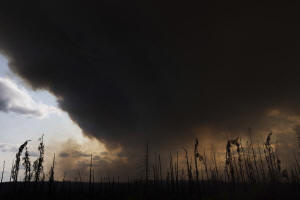Thousands evacuated in 3 provinces as Canadian wildfires threaten air
quality into some US states
[June 02, 2025]
FLIN FLON, Manitoba (AP) — More than 25,000 residents in three provinces
have been evacuated as dozens of wildfires remained active Sunday and
diminished air quality in parts of Canada and the U.S., according to
officials.
Most of the evacuated residents were from Manitoba, which declared a
state of emergency last week. About 17,000 people there were evacuated
by Saturday along with 1,300 in Alberta. About 8,000 people in
Saskatchewan had been relocated as leaders there warned the number could
climb.
Smoke was worsening air quality and reducing visibility in Canada and
into some U.S. states along the border.
“Air quality and visibility due to wildfire smoke can fluctuate over
short distances and can vary considerably from hour to hour,”
Saskatchewan’s Public Safety Agency warned Sunday. “As smoke levels
increase, health risks increase.”
Saskatchewan Premier Scott Moe said firefighters, emergency crews and
aircraft from other provinces and U.S. states, including Alaska, Oregon
and Arizona, were being sent to help fight the blazes.
“We are truly grateful, and we stand stronger because of you,” Moe said
in a post on social media.
He said ongoing hot, dry weather is allowing some fires to grow and
threaten communities, and resources to fight the fires and support the
evacuees are stretched thin.

“The next four to seven days are absolutely critical until we can find
our way to changing weather patterns, and ultimately a soaking rain
throughout the north,” Moe said at a Saturday news conference.
In Manitoba, more than 5,000 of those evacuated are from Flin Flon,
located nearly 645 kilometers (400 miles) northwest of the provincial
capital of Winnipeg. In northern Manitoba, fire knocked out power to the
community of Cranberry Portage, forcing a mandatory evacuation order
Saturday for about 600 residents.
The fire menacing Flin Flon began a week ago near Creighton,
Saskatchewan, and quickly jumped the boundary into Manitoba. Crews have
struggled to contain it. Water bombers have been intermittently grounded
due to heavy smoke and a drone incursion.
The U.S. Department of Agriculture’s Forest Service deployed an air
tanker to Alberta and said it would send 150 firefighters and equipment
to Canada.
In some parts of the U.S., air quality reached “unhealthy” levels Sunday
in North Dakota and small swaths of Montana, Minnesota and South Dakota,
according to the U.S. Environmental Protection Agency’s AirNow page.
[to top of second column]
|

Wildfire smoke hangs in the air above Highway 97 north of
Buckinghorse River, British Columbia, on Friday, May 30, 2025. (Nasuna
Stuart-Ulin/The Canadian Press via AP)

“We should expect at least a couple more rounds of Canadian smoke to
come through the U.S. over the next week,” said Bryan Jackson, a
meteorologist with the National Weather Service in the U.S.
Separately, a fire in the U.S. border state of Idaho burned at least
100 acres (40 hectares) as of Sunday, prompting road closures and
some evacuations, according to the Idaho Department of Lands. The
agency said in a news release that at least one structure was
burned, but did not provide additional details about the damage.
Strong gusty winds of 15 to 20 mph (24 to 32 kph) and steep terrain
were making it difficult for firefighters battling the fire, which
ignited Saturday.
Evacuation centers have opened across Manitoba for those fleeing the
fires, one as far south as Winkler, 20 kilometers (12 miles) from
the U.S. border. Winnipeg opened up public buildings for evacuees as
it deals with hotels already crammed with other fire refugees,
vacationers, business people and convention-goers.
Manitoba’s Indigenous leaders said Saturday at a news conference
that hotel rooms in the cities where evacuees are arriving are full,
and they called on the government to direct hotel owners to give
evacuees priority.
Assembly of Manitoba Chiefs Grand Chief Kyra Wilson said it was one
of the largest evacuations in the province since the 1990s.
“It’s really sad to see our children having to sleep on floors.
People are sitting, waiting in hallways, waiting outside, and right
now we just need people to come together. People are tired,” Wilson
said at a news conference.
Canada’s wildfire season runs from May through September. Its
worst-ever wildfire season was in 2023. It choked much of North
America with dangerous smoke for months.
___
Associated Press reporter Julie Walker contributed from New York.
All contents © copyright 2025 Associated Press. All rights reserved
 |